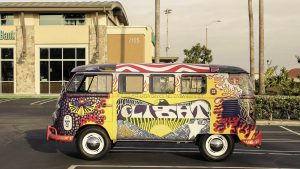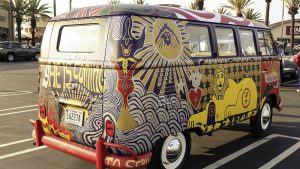AUTOCULTURE: The “Lightbus” is rolling again!
Woodstock should be familiar to everyone – and so should the “Bulli”. One of the most beautiful painted Volkswagen T1s comes from the artist Dr. Bob Hieronimus, who has revived his bus from back then.
The message of the Lightbus is: “We are all one”.
Mud, music and 400,000 people: At the Woodstock Festival, the alternative movement of the beatniks and hippies 50 years ago became a mass phenomenon. “Woodstock” still stands for love and peace, for Jimi Hendrix and Janis Joplin, for the Age of Aquarius. And for a lot of rain – ergo the mud. The whole festival became cult, and some images gently nestled in the cultural memory: Jimi Hendrix with his guitar and version of the “Star Spangled Banner”, young people, laughing, dancing in the rain, their bare feet in the mud – and also perhaps one of the most famous buses in the world, the so-called “Lightbus”. A Volkswagen T1, a Bulli, painted wildly and anarchically with esoteric symbols in bright colours.
Woodstock is a legend, but the man who painted the bus was not even present at the festival, neither as an artist nor as a spectator: Bob Hieronimus, a doctor of symbology and enthusiastic car painter. The 75-year-old today is surrounded by an aura of cheerful serenity.
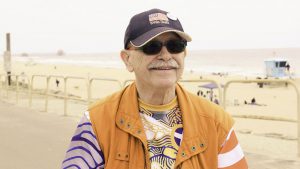
The Woodstock Festival was supposed to take place from 15 to 17 August 1969 in New York State in the USA, but it actually ended on the morning of 18 August. It did not take place in Woodstock – the organisers did not get a permit there – but in the small town of Bethel, about 70 kilometres away from Woodstock. Around 30 musicians performed, including Jimi Hendrix, Janis Joplin, Grateful Dead, Joan Baez, Crosby Stills Nash & Young, Santana and The Who. About half a million visitors came. This basically made the festival the second largest city in New York State for three days.
A house on wheels
“The Volkswagen bus is a house on wheels,” says Bob, “and was suitable for people with little money at the time. It’s great: you can travel in it and meet other people!” Hieronimus has painted numerous cars, including many buses. “In my opinion, the Volkswagen Bus is ultimately about one thing: love.” Especially with the Lightbus. Its main message, 50 years ago as well as today, is: “We are all one, together on this one planet. We are all in the same boat,” explains Bob. That’s why he chose symbols from different cultures and languages for his bus, from Hebrew to ancient Egyptian to Sanskrit.
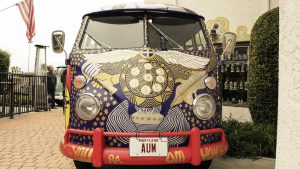
“I researched page after page, in different languages. I wanted others to understand what it was all about. It took me six months to paint the original bus.” Fifty years later, Bob directed a small group of artists to help him paint the new Lightbus. The old Lightbus had gone missing sometime in the 1970s – and Canadian documentary filmmaker John Chisholm had the idea to revive the bus on the occasion of the 50th anniversary of Woodstock.
Together with Bob, he set out on a futile search for the original. Eventually, with the help of Volkswagen, Bulli fans and a Kickstarter campaign, the two finally found another T1, which they lovingly restored: The Lightbus was back on the road!
“People love the Lightbus!”
“The Lightbus became famous because many understood its message of love. And we resurrected it because so many people came to me asking where the bus was. So we did it,” says Bob. He and John Chisholm have been touring the US since May this year, showing the bus at various car shows and finally driving it to where it all began: Woodstock.
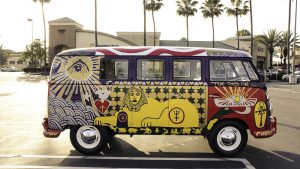
“That’s the plan. I’m looking forward to finally getting there. I’m sorry I couldn’t make it last time,” says Bob, talking about how excited people are when the Lightbus rolls past them: “They start clapping, singing and waving. They just love it!” The Lightbus is also the highlight at a car show in Los Angeles. Visitors hug Bob, take pictures of him and the bus. “He represents the whole idea of the hippie movement back then,” explains classic car fan Don Ramsay.
Woodstock ’69: a few facts
The full name of the festival was “Woodstock Music & Art Fair presents An Aquarius Exhibition – 3 Days of Peace & Music”.
The organisers expected about 200,000 visitors. However, more than twice as many came – food became scarce, yet it remained peaceful.
At that time, a day ticket cost seven dollars – equivalent to about 40 euros today.
Because so many visitors arrived and camped beforehand, the ticket booths had not yet been set up. In the end, it was impossible to check the tickets – and the visit became free.
Electrification: the best for the planet
At the end, Bob Hieronimus formulates another parallel between then and now – then it was about saving people from war and armament, today it is about saving the planet per se: “The world needs a big change now. We have to work together.” He is correspondingly euphoric about Volkswagen’s big electric offensive. “We have to stop using petroleum. We have no choice. E-mobility is the best thing Volkswagen can do for the future of the planet.”
The new ID. BUZZ he has also already taken a close look at: “It has a beautiful shape – I would love to paint it one day. Maybe with the theme: Love the Earth.”
Brand: Volkswagen
virtualdesignmagazine Michael Hiller


